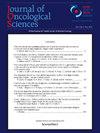Comparison of Clinicopathological Characteristics of BRCA1 and BRCA2 Carriers with Breast Cancer: The Role of Ki-67 Index
Q4 Medicine
引用次数: 0
Abstract
91 One in 8 women in the community are predisposed to develop breast cancer, and this risk significantly escalates in women with a family history of breast carcinoma.1,2 Approximately, 10% of breast cancers are hereditary, and mutation in the breast cancer (BRCA) gene is one of the best-known mutations associated with breast cancer.2-5 The factors that increase the chances of a BRCA mutation in breast cancer include young age (<40 years), triple-negative tumors, male gender, family history, ovarian cancer, and bilateral breast cancer.6 Currently, BRCA mutations are evaluated in 2 subgroups, BRCA1 and BRCA2, and patients with BRCA mutations can develop secondary malignancies.BRCA1和BRCA2携带者乳腺癌临床病理特征的比较:Ki-67指数的作用
91社区中每8名妇女中就有1人易患乳腺癌,有乳腺癌家族史的妇女患乳腺癌的风险显著增加。大约10%的乳腺癌是遗传性的,而乳腺癌(BRCA)基因突变是与乳腺癌相关的最著名的突变之一。增加乳腺癌BRCA突变几率的因素包括年轻(<40岁)、三阴性肿瘤、男性、家族史、卵巢癌和双侧乳腺癌目前,BRCA突变被评估为2个亚组,BRCA1和BRCA2, BRCA突变患者可发展为继发性恶性肿瘤。
本文章由计算机程序翻译,如有差异,请以英文原文为准。
求助全文
约1分钟内获得全文
求助全文
来源期刊

Journal of Oncological Sciences
Medicine-Oncology
CiteScore
0.10
自引率
0.00%
发文量
16
审稿时长
29 weeks
 求助内容:
求助内容: 应助结果提醒方式:
应助结果提醒方式:


